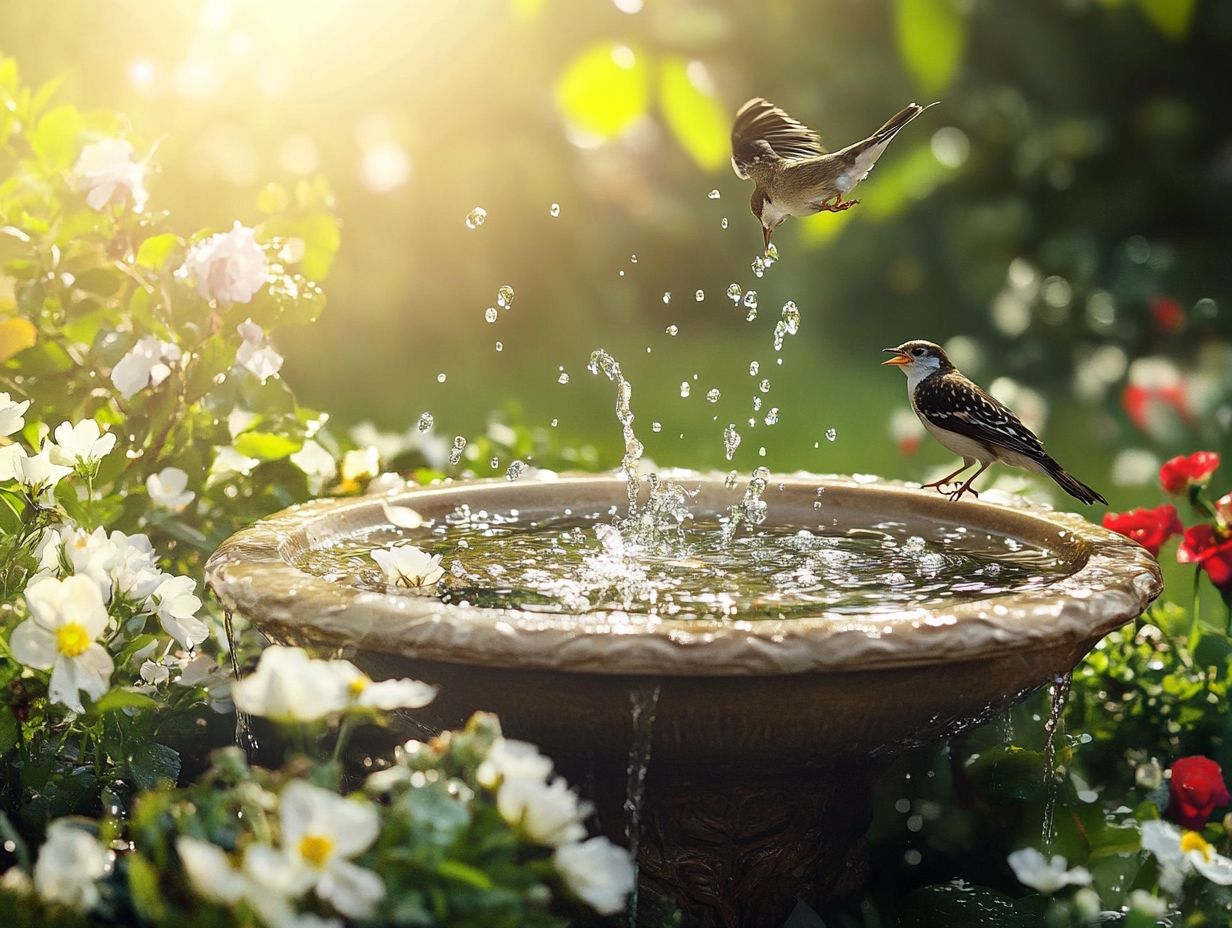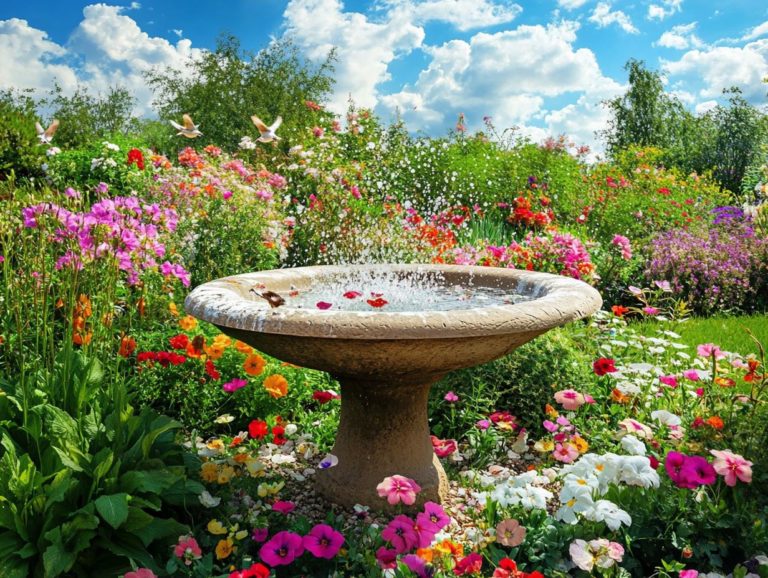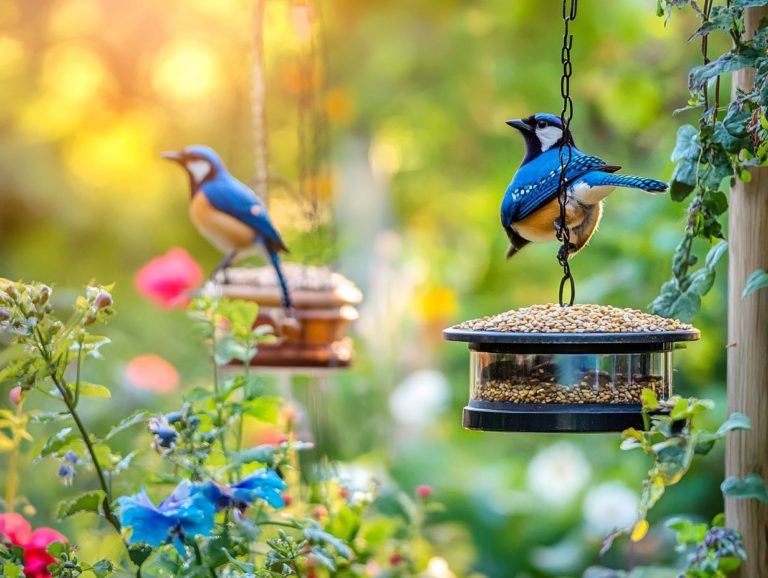How Often Should You Change Bird Bath Water?
Keeping your bird bath filled with clean water is essential for the health and happiness of your feathered friends, particularly during the summer months when attracting various bird species is a priority.
Fresh water not only attracts birds but also prevents the spread of diseases. It provides them with a safe space to bathe and hydrate. This article delves into the importance of regularly changing the water in your bird bath, the factors that can affect its quality, such as evaporation rates and temperature fluctuations. You’ll also find guidelines on how often to make those changes.
Additionally, you’ll learn to recognize the signs that indicate it s time for a refresh. Discover practical tips for maintaining a pristine bathing environment, which can enhance the care you provide for your avian visitors.
Whether you re an experienced birdwatcher or just beginning your journey, grasping these concepts will empower you to create a welcoming oasis for your feathered friends.
Contents
- Key Takeaways:
- Importance of Clean Bird Bath Water
- What Affects Water Quality?
- How Often to Change Bird Bath Water
- Signs that Water Needs to be Changed
- Tips for Maintaining Clean Water
- Frequently Asked Questions
- How Often Should You Change Bird Bath Water?
- Why is it important to change bird bath water regularly?
- Should I change the water more often during hot weather?
- Can I just refill the bird bath without changing the water?
- Is it necessary to clean the bird bath before refilling it with fresh water?
- What can I do to prevent the water from getting dirty too quickly?
Key Takeaways:

- Regularly changing bird bath water is crucial for the health and well-being of birds.
- Factors such as weather and location can affect the quality of bird bath water.
- Look for signs of contamination, like algae, and act quickly.
Importance of Clean Bird Bath Water
A pristine bird bath is essential for any backyard habitat. It provides a safe and refreshing water source that attracts various bird species while promoting their health.
Regularly maintaining water quality helps minimize the green stuff that can grow in water and prevents the spread of diseases. This makes it vital for any passionate bird enthusiast.
By placing fresh water in a shady spot, you can significantly enhance the experience for your feathered friends while positively impacting the local environment.
Why Regular Water Changes are Necessary
Regularly changing the water in your bird bath is crucial for creating a clean and inviting environment that draws a variety of bird species.
Ensuring the water stays fresh and free of contaminants enhances the aesthetic appeal of your space and significantly contributes to the well-being of your feathered visitors.
Frequent water changes help prevent algae buildup, which can discourage birds from visiting and negatively impact their health. Clean water promotes active and healthy behaviors, encouraging birds to bathe and hydrate regularly.
This simple maintenance routine enriches their experience and cultivates a thriving bird-friendly habitat right in your backyard.
What Affects Water Quality?
The quality of water in a bird bath can be significantly influenced by various environmental factors. Temperature fluctuations, evaporation rates, and the presence of algae all play crucial roles in shaping the overall habitat for visiting birds.
By being mindful of these elements, you can create a more welcoming and beneficial environment for your feathered friends.
Environmental and Biological Factors

Understanding the environmental and biological factors that affect water quality is essential for creating an ideal habitat for birds.
Elements such as temperature and geographic location significantly influence water quality, which directly impacts the availability of food sources for these bird species.
For example, warmer waters can lead to a surge in algae growth, depleting oxygen levels and affecting fish populations that birds depend on for food.
Certain locations may boast unique vegetation that provides shelter and nesting sites, further influencing bird behavior and habitat preferences. This intricate interplay of environmental conditions determines where birds choose to settle and affects their reproductive success and migratory patterns, ultimately enriching the biodiversity of the ecosystem.
How Often to Change Bird Bath Water
Determining how often you should change the water in your bird bath is essential for keeping it pristine and inviting. This ensures it remains a safe haven for the delightful array of bird species that come to visit.
Guidelines for Frequency of Water Changes
Establishing clear guidelines for how often you change the water in your bird bath can significantly elevate the quality of the water available to your feathered friends. This makes the area more appealing for attracting birds.
Regular maintenance is essential, particularly during those sweltering summer months when evaporation rates soar and birds become more active. For instance, if you live in a warm climate or it’s peak bird activity time, you might want to consider changing the water daily.
On the other hand, during cooler seasons or in areas with less avian activity, replacing it every two to three days should do the trick. Keep in mind that factors like debris, pollen, or algae growth can affect this schedule. It s wise to regularly monitor the condition of the bath.
By staying vigilant about these variables, you can create an inviting and safe environment for your local avian visitors.
Signs that Water Needs to be Changed
Spotting these signs is vital! Recognizing when your bird bath water needs changing is crucial for fostering a clean and healthy environment for your feathered friends. By staying attentive to these indicators, you can ensure that your bird bath remains a refreshing oasis for the birds that visit.
Identifying and Addressing Contaminated Water

Identifying contaminated water in your bird bath is crucial for creating a safe haven for birds. There are specific signs you should be vigilant about.
If you see any unusual discoloration, such as murky or cloudy water, or floating debris, change it immediately. An unpleasant odor or an overabundance of algae are also red flags that the water may not be safe for your avian visitors.
To address these concerns, it s essential to change the water frequently, ideally every few days, and to clean the bath thoroughly with a mild, bird-safe detergent. Regularly checking for and removing any debris, such as leaves or dirt, will help you keep the bathing area clean and safe.
Tips for Maintaining Clean Water
By implementing effective strategies for maintaining clean water in your bird bath, you can greatly enhance the experience for both the birds and those who appreciate their presence. A fresh and inviting habitat not only attracts feathered visitors but also elevates your enjoyment of their beauty and behaviors.
Preventive Measures and Maintenance Techniques
Employing preventive measures and effective maintenance techniques is essential for ensuring that the water in your bird bath remains clean and inviting for your feathered friends. Establishing a regular cleaning routine scrubbing the basin with mild soap and rinsing thoroughly can significantly curb algae growth and bacterial contamination.
Installing features like solar fountains not only aerates the water, making it irresistible to birds, but also keeps it cooler and fresher during those sweltering days. By regularly changing the water and inspecting the bird bath for debris or obstructions, you create a continuous flow that nurtures a healthier environment.
Consider positioning the bird bath in a shaded area to minimize direct sunlight, further enhancing its allure to visiting birds.
Frequently Asked Questions
How Often Should You Change Bird Bath Water?

The recommended frequency for changing bird bath water is at least once a week, especially during peak activity periods in warmer climates.
Why is it important to change bird bath water regularly?
Bird bath water can quickly become dirty and contaminated, posing a health risk to birds and leading to the spread of diseases if not properly maintained. Regularly changing the water helps keep the bathing area clean and safe for them.
Keep an eye on your bird bath, and help our feathered friends thrive!
Should I change the water more often during hot weather?
Yes! Change the bird bath water every other day in hot weather. This helps prevent bacteria and algae growth.
Can I just refill the bird bath without changing the water?
No, refilling only adds water. It won’t remove dirt or debris. Clean the bath regularly to maintain a healthy environment for the birds.
Is it necessary to clean the bird bath before refilling it with fresh water?
Absolutely! Use hot water and mild soap or a bird-safe cleaner. A bird-safe cleaner is one that is non-toxic to birds and won t harm them. This ensures the bath is clean and free of harmful bacteria.
What can I do to prevent the water from getting dirty too quickly?
Place the bird bath in a shaded area to keep the water cleaner. Consider adding a dripper feature to keep water circulating and attract more birds.
Regularly scrub and rinse the bath to maintain its freshness and invite more feathered friends!






